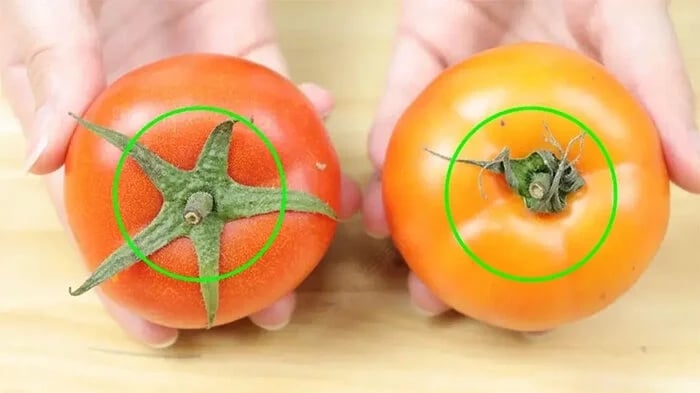Tomatoes are a common fruit found in family meals. They are nutritious, delicious, and especially good for your health. However, to speed up the ripening process, some people use chemicals to ripen them, which can be harmful to your health when consumed.
So, how can you differentiate between naturally ripened and chemically ripened tomatoes?
Observe the color
Naturally and chemically ripened tomatoes usually differ in color. Naturally ripened tomatoes, due to sun exposure, have varying colors on the same fruit. The area near the stem will be slightly green, and the ripening progresses towards the bottom of the fruit.
On the other hand, chemically ripened tomatoes tend to be uniformly ripe, with an attractive, consistent color. Even the area near the stem, which receives less sunlight, turns a deep red.

Naturally and chemically ripened tomatoes differ in color.
Examine the bottom of the tomato
Looking at the bottom of a tomato is an easy way to determine if it has been treated with chemicals. Naturally ripened tomatoes are usually round and symmetrical, plump, and slightly concave at the top.
Conversely, tomatoes with protruding tops or odd shapes are likely the result of improper fertilization or a poor growing environment and may have been forced to ripen with chemicals.
Inspect the tomato’s calyx
Naturally ripened tomatoes typically have a dark green calyx with fresh, taut branches, and a slightly sunken stem.
On the other hand, if the calyx is yellow or purple, the tomato is likely of poor quality, wilted, picked a long time ago, or treated with chemicals.

Naturally ripened tomatoes have a dark green calyx with fresh, taut branches and a slightly sunken stem.
Check the weight of the tomato
Naturally ripened tomatoes tend to be denser and feel heavier when held. They have a soft, plump texture, whereas chemically ripened tomatoes are often harder and more difficult to juice.




































